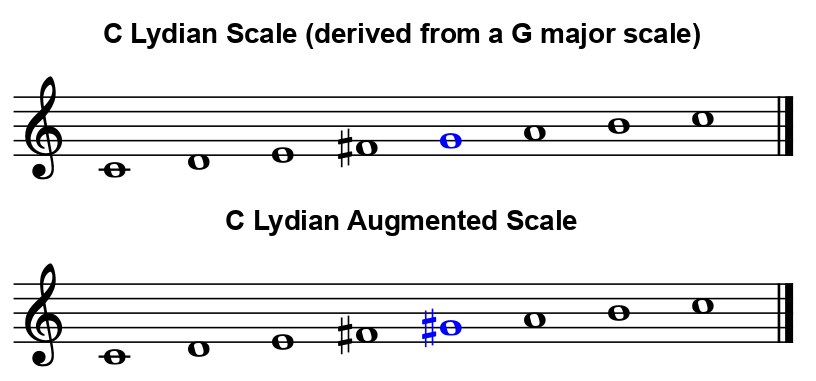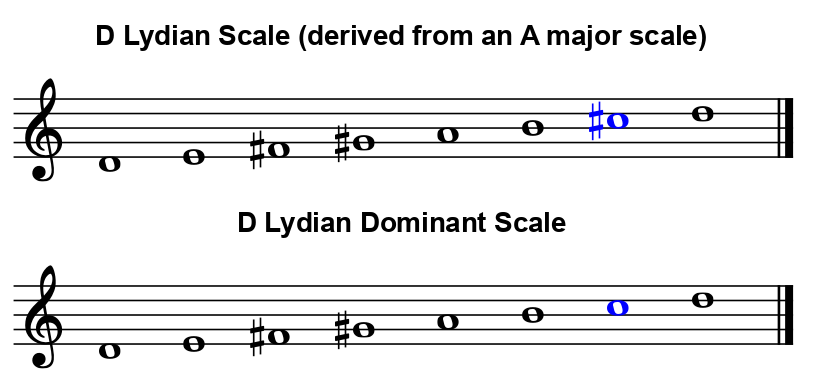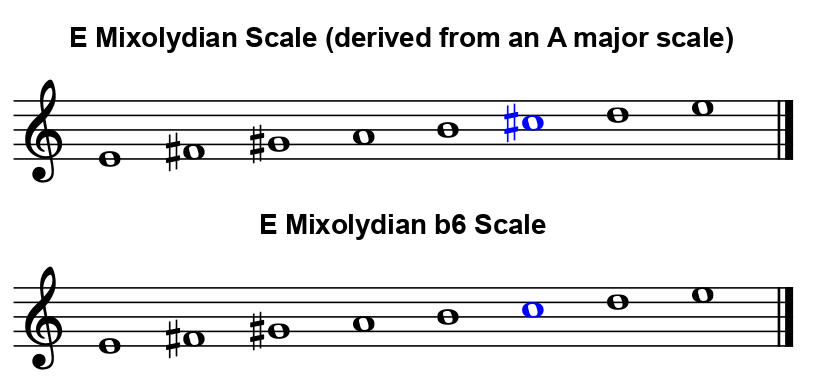Whereas the relative approach relates each of the modes to the melodic minor scale from which it is derived, the parallel approach views each mode as an independent scale.
As such, each of the modal scales can be compared with another similar scale with the same root note.
This post will compare the modes of the melodic minor scale with the closely related modes of the major scale.
It will also provide common fingerings for each of the modes, along with instruction on how to play them on a guitar with any root note.
The Modes of the Melodic Minor Scale
Each mode of the melodic minor scale can be constructed by altering a corresponding mode of the major scale.
For example:
- A melodic minor scale can be constructed by altering a major scale.
- A Dorian b2 scale can be constructed by altering a Dorian scale.
- A Lydian #5 scale can be constructed by altering a Lydian scale.
- A Lydian b7 scale can be constructed by altering a Lydian scale.
- A Mixolydian b6 scale can be constructed by altering a Mixolydian scale.
- A Locrian #2 scale can be constructed by altering a Locrian scale.
- An altered scale can be constructed by altering a Locrian scale.
Melodic Minor Scale
A melodic minor scale is a major scale with a flatted third scale degree.
To construct a melodic minor scale:
- Write out the notes in the major scale with the same root note.
- Lower the third scale degree a half step.
To construct an A melodic minor scale:
- Write out the notes in an A major scale.
- Lower the third scale degree from C# to C (fig.1).
Fig.1

An A melodic minor scale contains the notes A, B, C, D, E, F# and G#.
Dorian b2 Scale
A Dorian b2 scale is a Dorian scale with a flatted second scale degree.
To construct a Dorian b2 scale:
- Write out the notes in the Dorian scale with the same root note.
- Lower the second scale degree a half step.
To construct a B Dorian b2 scale:
- Write out the notes in a B Dorian scale.
- Lower the second scale degree from C# to C (fig.2).
Fig.2

A B Dorian b2 scale contains the notes B, C, D, E, F#, G#, and A.
Lydian #5 (or Lydian Augmented) Scale
A Lydian augmented scale is a Lydian scale with a sharped fifth scale degree.
To construct a Lydian augmented scale:
- Write out the notes in the Lydian scale with the same root note.
- Raise the fifth scale degree a half step.
To construct a C Lydian augmented scale:
- Write out the notes in a C Lydian scale.
- Raise the fifth scale degree from G to G# (fig.3).
Fig.3

A C Lydian augmented scale contains the notes C, D, E, F#, G#, A and B.
Lydian b7 (or Lydian Dominant) Scale
A Lydian dominant scale is a Lydian scale with a flatted seventh scale degree.
To construct a Lydian dominant scale:
- Write out the notes in the Lydian scale with the same root note.
- Lower the seventh scale degree a half step.
To construct a D Lydian dominant scale:
- Write out the notes in a D Lydian scale.
- Lower the seventh scale degree from C# to C (fig.4).
Fig.4

A D Lydian b7 scale contains the notes D, E, F#, G#, A, B and C.
Mixolydian b6 Scale
A Mixolydian b6 scale is a Mixolydian scale with a flatted sixth scale degree.
To construct a Mixolydian b6 scale:
- Write out the notes in the Mixolydian scale with the same root note.
- Lower the sixth scale degree a half step.
To construct an E Mixolydian b6 scale:
- Write out the notes in an E Mixolydian scale.
- Lower the sixth scale degree from C# to C (fig.5).
Fig.5

A E Mixolydian b6 scale contains the notes E, F#, G#, A, B, C and D.
Locrian #2 Scale
A Locrian #2 scale is a Locrian scale with a sharped second scale degree.
To construct a Locrian #2 scale:
- Write out the notes in the Locrian scale with the same root note.
- Raise the second scale degree a half step.
To construct an F# Locrian #2 scale:
- Write out the notes in an F# Locrian scale.
- Raise the second scale degree from G to G# (fig.6).
Fig.6

A F# Locrian #2 scale contains the notes F#, G#, A, B, C, D and E.
Altered Scale
An altered scale is a Locrian scale with a flatted fourth scale degree.
To construct an altered scale:
- Write out the notes in the Locrian scale with the same root note.
- Lower the fourth scale degree a half step.
To construct a G# altered scale:
- Write out the notes in a G# Locrian scale.
- Lower the fourth scale degree from C# to C (fig.7).
Fig.7

A G# altered scale contains the notes G#, A, B, C, D, E and F#.
Modes of the Melodic Minor Scale on a Guitar: The Parallel Approach
With the parallel approach to modes, each mode is treated as an independent scale.
With this approach, to play a modal scale on a guitar we have two options:
- Learn a separate fingering for each modal scale.
- Play the corresponding mode of the major scale with the same root note, but alter the appropriate note.
The first option is by far the easier one and the one we will use in this post.
Dorian b2 Scale
Fig.8a shows a common fingering for a Dorian b2 scale.
To play a B Dorian b2 scale, start the pattern on the B on the sixth string, seventh fret (fig.8b).
Fig.8

Lydian #5 (or Lydian Augmented) Scale
Fig.9a shows a common fingering for a Lydian augmented scale.
To play a C Lydian augmented scale, start the pattern on the C on the sixth string, eighth fret (fig.9b).
Fig.9

Lydian b7 (or Lydian Dominant) Scale
Fig.10a shows a common fingering for a Lydian dominant scale.
To play a D Lydian dominant scale, start the pattern on the D on the sixth string, 10th fret (fig.10b).
Fig.10

Mixolydian b6 Scale
Fig.11a shows a common fingering for a Mixolydian b6 scale.
To play an E Mixolydian b6 scale, start the pattern on the E on the sixth string, 12th fret (fig.11b).
Fig.11

Locrian #2 Scale
Fig.12a shows a common fingering for a Locrian #2 scale.
To play an F# Locrian #2 scale, start the pattern on the F# on the sixth string, second fret (fig.12b).
Fig.12

Altered Scale
Fig.13a shows a common fingering for an altered scale.
To play a G# altered scale, start the pattern on the G# on the sixth string, fourth fret (fig.13b).
Fig.13

Related Posts
Related posts include:
